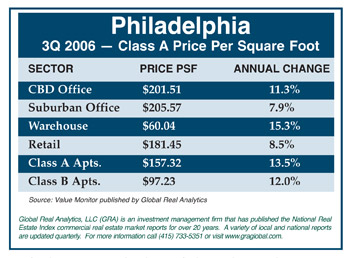|
NORTHEAST SNAPSHOT, JANUARY 2007
Philadelphia Office Market
The Philadelphia office market has continued to show steady improvement, aided by rising corporate profits, steady job growth and the emergence of the life sciences and biotech industries. Currently, the city is experiencing a direct vacancy rate of 11.6 percent with an overall vacancy rate of 13.2 percent. Class A rental rates range from $20 to $35 per square foot with an average of $25.72 per square foot. The office market has experienced a decrease in the availability of large blocks of space because of tenant absorbency patterns that have developed throughout Philadelphia’s office regions. A demand for space has been spread among the city’s diverse mix of industries and tenants with strong concentrations of law firms, financial companies and large corporate tenants.
The majority of absorption is occurring in Philadelphia’s Central Business District (CBD), especially within the West of Broad submarket where three major leases were recently signed. Republic First Bancorp has leased 53,275 square feet of Class A office space at Two Liberty Place, Aramark Corporation has leased 42,616 square feet of Class A office space at Bell Atlantic Tower, and Landan Engineering has leased 30,652 square feet of Class A office space at United Plaza. The Comcast Corporation has also signed on for significant additional space in the CBD area.
Philadelphia’s CBD is also experiencing a great deal of development activity in the downtown area. The 28-story Cira Centre, located at 2929 Arch Street, was completed in October 2005 and contains 727,725 square feet of rentable space. Also, CommerzLeasing & Immobilien AG, in a joint venture with Liberty Property Trust, is currently developing the Comcast Center, a 1.25-million-square-foot office building in the heart of Philadelphia’s CBD. Upon completion, the Comcast Center will be the tallest building in Philadelphia and will contain a 120-space underground parking garage, a public park and a 500-seat food court. Construction completion is scheduled for late 2007.
Existing incentive programs, such as the Keystone Innovation Zone (KIZ) program, a development-funding program provided by Pennsylvania’s Department of Community and Economic Development, have been catalysts for development within the life sciences and biotech industries. Philadelphia is ranked as one of the top three biotech markets in the U.S. because of its ability to build and expand existing institutions within the area. Much of this activity is occurring in the University City area of Philadelphia. This past fall, ground was broken on Phase I of the $600 million Science Center expansion, which will provide additional facilities for growing life science and technology companies. Phase I construction, currently located at 3711 Market Street, will consist of a 500-space parking structure, approximately 130,000 square feet of wet laboratory research space and 15,000 square feet of retail space. Phase I completion is scheduled for late 2007. The project’s master plan will consist of the expansion of 1.8 million square feet with the addition of 40 new life science and high-tech companies. Completion is scheduled for 2010. The expansion is currently being developed by a joint venture between The Science Center and Wexford Science & Technology, one of Philadelphia’s newest developers. The Baltimore-based development company specializes in the construction of real estate associated with science and technology based organizations. Their portfolio includes the development of the Hershey Center of Applied Research in Pennsylvania and the Tyco International building in New Jersey.
Another major development planned in the University City area is the University of Pennsylvania’s Penn Connects, a 30-year redevelopment plan of the former U.S. Postal Service facility along the Schuylkill River area. The university has purchased a 24-acre parcel of former industrial property, which it plans to convert into research and academic property, retail shops, office towers, arts and cultural spaces, athletic fields and parks. The project will contain a 400-bed residence hall at Chestnut Street between 24th and 33rd streets, a nanotechnology research center for the School of Engineering and Applied Science at Walnut and 32nd street and the conversion of surface parking lots into recreational sports facilities and open parks.
A majority of the activity has been occurring in the West of Market submarket within the past several years; however, the East of Broad submarket is displaying strong development potential. The Public Ledger Building and the Curtis Center were recently sold, and both buildings are expected to undergo renovations. Other future developments in the area include the long awaited Philadelphia Convention Center, which recently received funding for an expansion project scheduled to be complete in 2009, and the Girard Estate site, an entire city block across from the convention center that is scheduled for redevelopment. Each property will continue to strengthen the Philadelphia office market as it expands to welcome new tenants and developments.
— Jeffrey Williams is the associate director of Cushman & Wakefield’s Pennsylvania office.

©2007 France Publications, Inc. Duplication
or reproduction of this article not permitted without authorization
from France Publications, Inc. For information on reprints
of this article contact Barbara
Sherer at (630) 554-6054.
|
